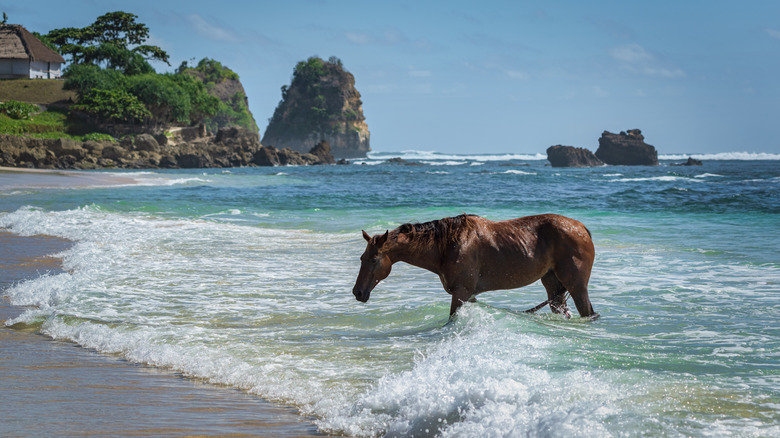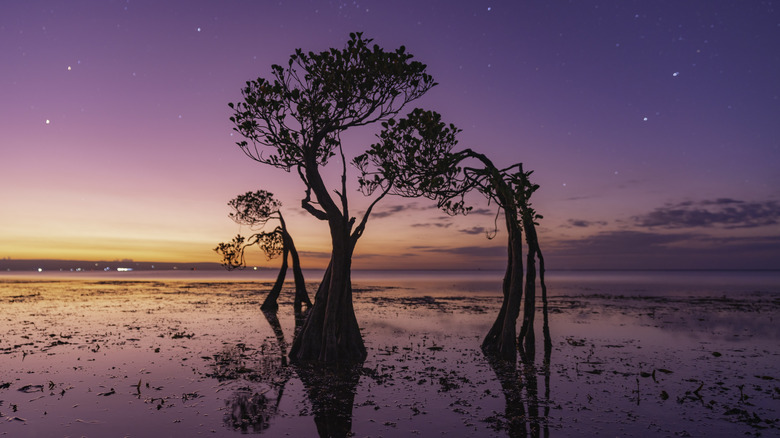Swap Bali's Crowded Shores For This Gorgeous Indonesian Island With Palm-Lined Beaches And Natural Pools
The island of Bali is one of the most popular tourist destinations in the Indonesian archipelago. A whopping 6 million visitors came to Bali in 2024, and the numbers are rising. But did you know the country has more than 17,000 islands spanning three time zones? Indonesia's islands offer plenty of choice, from tiny atolls fringed with coral reefs and imposing volcanoes thick with jungle, and these stunning tropical isles won't break the bank, either.
The islands east of Bali are now increasingly accessible. Just take the ever-popular Gili Islands or Lombok, Bali's stunning, uncrowded sister, all easily reachable by ferry. If you keep island-hopping past Lombok, you'll come to Sumba, an island of wild beauty, traditional villages, and ancient Stone Age sites. It's also one of the best-kept secrets for celebrity hideaways.
The easiest way to get here is to fly to Denpasar, Bali, then head to either Tambolaka Airport (TMC) on the western part of the island or Waingapu Airport (WGP/WATU) on the northern coast, depending on your itinerary. Remember that most foreign visitors to Indonesia will need a tourist visa. For some countries, like the U.S., you can get a visa on arrival for a fee at your first port of entry. Tourist visas are for trips shorter than 30 days (via Bali.com).
Remote villages, spectacular nature, and wild horses in Sumba
Sumba is not a small island in comparison to the others around it. It's nearly twice as big as Bali, with about one-sixth as many people. It feels far more remote with a stunning semi-arid landscape of hills and grasslands, completely different from Bali's lush tropical gardens and volcanoes. Public transportation is spotty across the island. So, renting a car with a knowledgeable driver is the best way to visit the various sites across Sumba.
On the island's west, the Waikuri Lagoon is a gorgeous saltwater lagoon renowned for its reflecting turquoise water. This area is also where the traditional village of Ratenggaro sits, with traditional steepled thatched-roof houses known as "uma" overlooking the sandy shores. Keep going along the southern coast and you'll come to Nihiwatu beach and its world-famous surf break, Occy's Left (named after world surfing champion Mark Occhilupo). Nihiwatu is also one place where Sumba's sandalwood ponies come for an afternoon swim, though they frequent other beaches too. Travel inland and you'll come to the tiered Lapopu waterfalls, spilling into a blue lake.
One of Sumba's most stunning sights is the 'dancing' mangrove trees of Walakiri beach on the island's east. The twisting trunks and branches of this mangrove forest are reflected in the water, especially at sunset. The Wairinding Hills in East Sumba are another picture-perfect spot with savannah grass that transforms from emerald green to golden yellow depending on the season.
Sustainable tourism in Sumba
The first beach resort on the island was a surf lodge in the 1980s that evolved into a luxury getaway. Now known as the Nihi Sumba, the hotel is ranked as one of the top hotels in the world for its understated luxury amid natural splendor. It's a favorite hideaway for celebrities like Jennifer Lawrence and the Beckhams. At more than $2,000 a night, however, the hotel is a luxury few can afford.
Consider instead accommodations that directly benefit the local community. The Maringi Sumba eco-resort is part hotel and part school, run by the Sumba Hospitality Foundation, whose aim is to build a sustainable tourism industry for the island. Their bamboo villas are a 20-minute drive from Tambolaka Airport, and they also organize expeditions to more remote areas, giving visitors the context they need to appreciate the island's unique culture and natural sites.
For locals who are starting to open the island to visitors, keeping Sumba's traditions and nature is vital. "For me, Sumba is not only a place where I was born and raised," Dempta Bato, a local hotelier, wrote on Instagram. "Sumba is beauty and love. An island that has magical powers to make anyone who visits Sumba feel its uniqueness, always longing to return." Of course, once you've visited one amazing island in Indonesia, you'll be tempted to keep exploring. If you want to see more of the archipelago's diverse nature, head to next-door Flores, an uncrowded Bali alternative with pink beaches and Komodo dragons.


